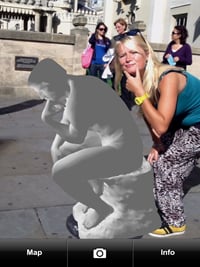Augmentation optional
The artz trail is taking art out of the gallery and onto the streets of Brighton. Nick Dunn explains the technology behind the project

The sea-side city of Brighton has its fair share of stunning public art, from Banksy on the sides of pubs, to the exceptional commissioned Graffiti behind the shopping streets of the North Laine area. The city also caters for an estimated eight-million tourists per year, streaming down the train line from London and directly onto the strangely-attracting, pebble-ridden beach.
The tourists do not, by-and-large, come to marvel at the art or to even inhabit any major galleries, but they are treated to the added bonus of free public art, once they begin to explore. The potential for exploration is a large part of the appeal of visiting Brighton; you never know what is around the corner.
In 2011 I began a project that would link technology with public art and tourism. Its premise was to build virtual sculpture parks on the streets and in the squares. These 3D sculptures would appear to passersby as thin air, but viewing the images through a smartphone or ipad would reveal the true extent of the augmented reality we had created.
The photographic nature of the experience is what makes it engaging. The West Pier in Brighton is one of the most photographed sites in the country. It is always there, majestically waiting to be captured on digital film.
The AR:Tz sites work in much the same way, passively waiting to be engaged in, or walked over and ignored. The reaction from people who see the app live is universal. First comes indifference, then they look at the screen in amazement as if witnessing a magic trick, next they look around the side of the ipad and ask the inevitable question: ‘How does that work then?’
The 3D computer animated sculptures are triggered when the camera on the phone or ipad identifies certain pictures we have programmed it to recognise. This feature of augmented reality is the reason that it melts into the development of new art mediums and possibilities – it is the difference between painting and sculpture, as it were.
From day one, the local council and Visit Brighton were hugely supportive of the initiative and we are eager to spread the artz trail to other cities, not just in the UK but worldwide. We believe we are kicking off a new global art movement with 3D animators as the new stars of the art community.
One of the next steps is to trigger pieces of art from walls in a more traditional gallery environment. We are expanding into visionary art mixed with 3D animation to create a more immersive experience.
The potential benefits for galleries, who can render their own main attractions in 3D, are huge. A technique known as sculptural photography makes it possible to capture an object or even a person’s form. This is done by taking many photographs of the object or person from different angles. For a person this requires setting up a ring of up to 70 cameras around them, in order to take the photographs simultaneously. These images are then processed through software to give a photo-real 3D version of the object or person. A gallery can then replicate and distribute this 3D image anywhere in the world through the use of an AR:Tz marker. Once the markers have been produced they can be printed in newspapers, publicity materials, magazines, on screen or as we have done, on pavements – making every street a potential gallery for new media art.
“Help me Obe-Wan, you’re my only hope” is closer than you might think with these techniques. And with the need to view the objects through a smartphone soon to be negated by the development of eyewear technology, there is potential for an even more immersive experience. For now, the humble 3D artz trail awaits interaction from those who wish to experience something augmented.
Join the Discussion
You must be logged in to post a comment.